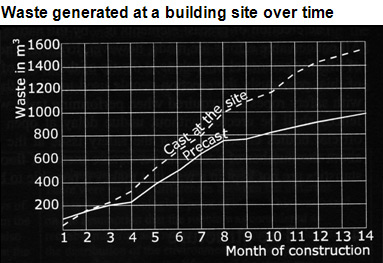In precast construction, the rigging of scaffolding, formwork, storage areas etc. is either not necessary or done only once. Scaffolding is generally not required for precast structures. Cranes are used to lift precast components into their place in a structure.
Transportation
When a building uses precast elements, large parts of the building can be brought to the site with each transport. Larger trucks consume less fuel per ton transported. Materials for formwork, scaffolding etc. are not required at the site and do not need to be transported.
Precast concrete structures are usually lighter than the equivalent area of on-site cast-in-place concrete. This can represent a significant reduction in the number of truck movements and reduced consumption of fossil fuels. The amount of energy consumed during the transport of precast elements is about 0.00114 MJ/kg/km. This represents 5% to 10% of the total energy consumption during manufacturing of precast concrete elements.
Construction Time
Precast concrete construction is nearly always faster when building the main parts of a structure. Components are manufactured in a precast plant at the same time as the foundations are being constructed at the site.
Precast units are normally large pieces, so greater parts of a building are completed with each activity compared to cast-in-place construction (formwork, scaffolding, reinforcement, concrete etc). Precast erection is fast and efficient, generally carried out using mobile cranes.
Total precast bridge structures (abutments, wingwalls, girders + decks and traffic barriers) can dramatically speed up construction and reduce inconvenience and detours for motorists.
Manpower
An erection team will consist of a crane and small crew. Experienced erectors can erect a whole frame and the floors and roof together with the walls of a building often before any other trades are engaged at the site.
The following are typical erection times:
- Erection of hollow core floor slabs - 300 m2 per working day
- Grouting of floor joints - 500 m2 per day
- Erection of columns - 8 pieces per day
- Erection of beams - 15 pieces per day
- Erection of double tee slabs - 25 pieces per day
- Erection of walls - 15 pieces per day
- Stair and elevator shafts - 2 floors per day
For commercial buildings (offices, shopping centers, schools etc.) about 100 m2 of a building can be erected each day, including the erection of all components and all necessary connections. The corresponding figure for the erection of apartment buildings is about 80 m2 per day. The difference is generally due to smaller pieces and stricter tolerances.
Waste
There is little waste to dispose of at a building site when the structure is precast. This was documented in a major investigation carried out in Sweden in 1996 where about 400 apartments were to be built. Ten similar buildings were selected, each containing 11 apartment buildings; five were precast and five were cast-in-place. Records were kept of the consumption of energy, materials, productivity, construction time, working environment, sick leaves, accidents, quality control, installation, waste generation and cost. The final result was the amount of waste at the building site was 35% less for the precast buildings compared with the cast-in-place buildings.
In 2001, close scrutiny was paid to the waste generation at a major project in Oslo, Norway. The buildings contain about 150,000 m2 of floor space. The structure was constructed using steel frames with precast hollow core floor and roof slabs. The delivery and erection of the steel frame and the slabs were combined in the precast contract. The surplus material generated at the site during the erection of these components was only about 1 kg per m2 of hollow core slab. The surplus material consisted mainly of wood, concrete and reinforcing steel from the grouting of the joints at the site. All surplus material, except some epoxy resin, was recycled, and was not considered as waste.

Inconvenience to the Public
Precast components can be brought to the site just-in-time by truck with considerable reduction in traffic and less obstruction of the public. No staging areas are required. The precast units are lifted directly from the trucks and placed in the structure without any stockpiling on the job site.





